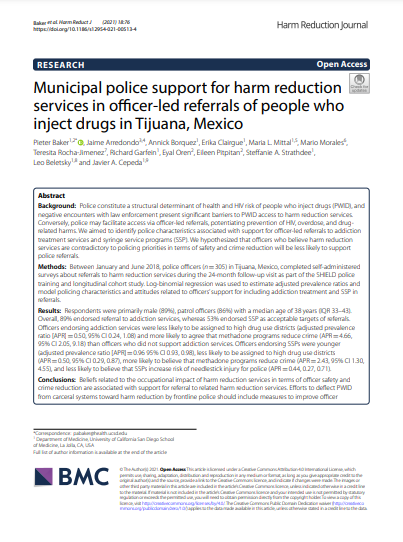Municipal police support for harm reduction services in officer-led referrals of people who inject drugs in Tijuana, Mexico

Fecha
2021-08-01Autor
Baker, Piete
Arredondo, Jaime
Borquez, Annick
Clairgue, Erika
Mittal, Maria L.
Morales, Mario
Garfein, Richard
Oren, Eyal
Pitpitan, Eileen
Strathdee, Steffanie A.
Beletsky, Leo
Cepeda, Javier A.
Rocha-Jimenez, Teresita [Univ Mayor, Fac Humanidades, Soc & Hlth Res Ctr, Santiago, Chile]
Ubicación geográfica
Notas
HERRAMIENTAS
Acceda a títulos restringidos
¿Cómo descargar?Resumen
Background Police constitute a structural determinant of health and HIV risk of people who inject drugs (PWID), and negative encounters with law enforcement present significant barriers to PWID access to harm reduction services. Conversely, police may facilitate access via officer-led referrals, potentiating prevention of HIV, overdose, and drug-related harms. We aimed to identify police characteristics associated with support for officer-led referrals to addiction treatment services and syringe service programs (SSP). We hypothesized that officers who believe harm reduction services are contradictory to policing priorities in terms of safety and crime reduction will be less likely to support police referrals. Methods Between January and June 2018, police officers (n = 305) in Tijuana, Mexico, completed self-administered surveys about referrals to harm reduction services during the 24-month follow-up visit as part of the SHIELD police training and longitudinal cohort study. Log-binomial regression was used to estimate adjusted prevalence ratios and model policing characteristics and attitudes related to officers' support for including addiction treatment and SSP in referrals. Results Respondents were primarily male (89%), patrol officers (86%) with a median age of 38 years (IQR 33-43). Overall, 89% endorsed referral to addiction services, whereas 53% endorsed SSP as acceptable targets of referrals. Officers endorsing addiction services were less likely to be assigned to high drug use districts (adjusted prevalence ratio [APR] = 0.50, 95% CI 0.24, 1.08) and more likely to agree that methadone programs reduce crime (APR = 4.66, 95% CI 2.05, 9.18) than officers who did not support addiction services. Officers endorsing SSPs were younger (adjusted prevalence ratio [APR] = 0.96 95% CI 0.93, 0.98), less likely to be assigned to high drug use districts (APR = 0.50, 95% CI 0.29, 0.87), more likely to believe that methadone programs reduce crime (APR = 2.43, 95% CI 1.30, 4.55), and less likely to believe that SSPs increase risk of needlestick injury for police (APR = 0.44, 0.27, 0.71). Conclusions Beliefs related to the occupational impact of harm reduction services in terms of officer safety and crime reduction are associated with support for referral to related harm reduction services. Efforts to deflect PWID from carceral systems toward harm reduction by frontline police should include measures to improve officer knowledge and attitudes about harm reduction services as they relate to occupational safety and law enforcement priorities. Trial Registration: NCT02444403.
URI
https://repositorio.umayor.cl/xmlui/handle/sibum/9070https://doi.org/10.1186%2Fs12954-021-00513-4
https://www.ncbi.nlm.nih.gov/pmc/articles/PMC8313001/pdf/12954_2021_Article_513.pdf
https://harmreductionjournal.biomedcentral.com/counter/pdf/10.1186/s12954-021-00513-4.pdf
https://escholarship.org/content/qt7cg2g6j0/qt7cg2g6j0.pdf?t=qxx5om
Coleccion/es a la/s que pertenece:
Si usted es autor(a) de este documento y NO desea que su publicación tenga acceso público en este repositorio, por favor complete el formulario aquí.